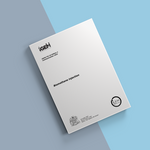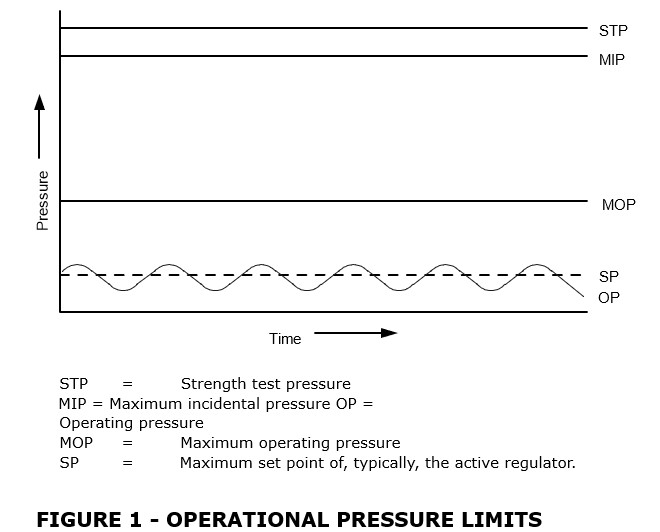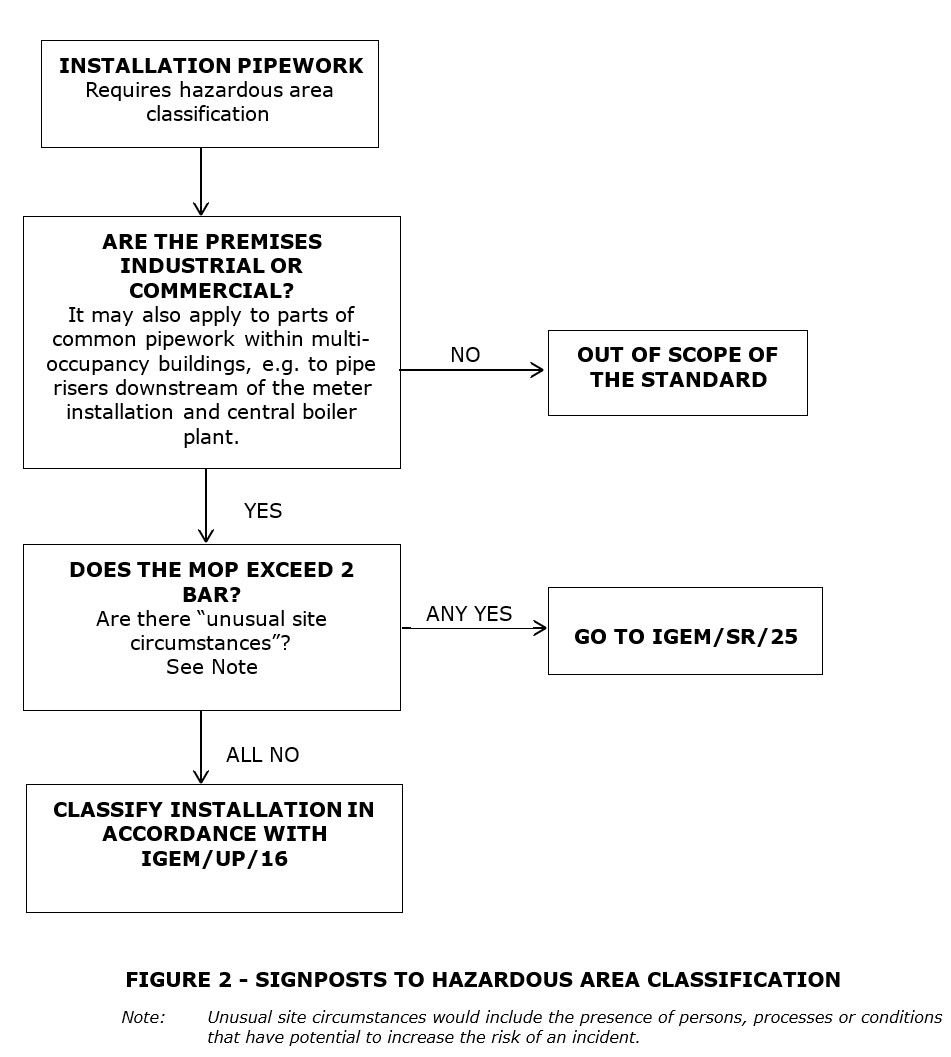IGEM/UP/16 Edition 2 - Design for natural gas installations on industrial and commercial premises with amendments November 2023

The IGEM standard IGEM/UP/16 Edition 2, entitled ‘Design for Natural Gas Installations on industrial and commercial premises with respect to DSEAR’ is intended to provide basic design information to enable designers and those undertaking risk assessments to achieve a gas installation that can be classified and maintained as Zone 2 Negligible Extent (Zone 2NE).
It is primarily for designers of new industrial and commercial pipework systems, downstream of the primary gas meter installation. It will also be useful for site occupiers who have the responsibility for compliance with DSEAR and for the production of site risk assessments for existing systems and new installations. Hazardous area assessment is normally a specialist activity requiring the application of IGEM/SR/25 Edition 2.
The standard covers new gas installation pipework, controls and associated gas appliances including appliance connections and pipework with an OP not exceeding 2 bar installed downstream of the primary meter installation in industrial and commercial premises. It may also apply to parts of common pipework within multi-occupancy domestic premises; for example, between pipework risers downstream of the meter installation and also to the central boiler plant. For hazardous area analysis of installations outside the scope of the Standard, reference should be made to IGEM/SR/25 Edition 2.
The advice on the preparation of risk assessments assumes that industrial and commercial gas installations and pipework have been designed, installed, commissioned and operated according to recognised standards such as IGEM/UP/2 and IGEM/UP/10. These assessments determine whether electrical equipment marked and declared as being suitable for use in a hazardous area are considered or used or if controls are required over other potential ignition sources such as hot surfaces, flames or sparks.
The standard will not purport to cover every gas installation as the diversity of gas installations is such that it is inappropriate to provide detailed requirements for all types of installation. It is recognised that special circumstances may occur, on an installation, for which some of the requirements will not, necessarily, be appropriate. In such cases, methods need to be developed by personnel of adequate competency and experience.
Introduction
1.1 This Standard supersedes Communication 1824 (2020) – 2nd Edition which is now obsolete.
1.2 It has been drafted by an Institution of Gas Engineers and Managers (IGEM) Panel, appointed by IGEM’s Gas Utilization Committee, and has been approved by IGEM’s Technical Co-ordinating Committee on behalf of the Council of IGEM.
1.3 The Dangerous Substances and Explosive Atmospheres Regulations (DSEAR) came into force in December 2002 and the requirements for the preparation of risk assessments to determine any hazardous area classification first came into force on 30th June 2003. They applied retrospectively to all installations within workplaces from 30th June 2006.
1.4 The intent of this Standard is to provide basic design information to enable designers and those undertaking risk assessments to achieve a gas installation that can be classified and maintained as Zone 2 Negligible Extent (Zone 2 NE). It is intended primarily for designers of new industrial and commercial pipework systems, downstream of the primary gas meter installation. It will also be useful for site occupiers who have the responsibility for compliance with DSEAR and for the production of site risk assessments for new and existing installations. Hazardous area assessment is normally a specialist activity requiring the application of IGEM/SR/25. Where doubt exists about the applicability of IGEM/UP/16, reference is to be made to IGEM/SR/25.
Note 1: Negligible extent (NE) is as described in BS EN 60079-10-1.
Note 2: This document is intended for guidance to achieve a Zone 2 NE classification and does not provide a procedure for a quantitative Zone analysis.
1.5 The guidance given in this document assumes that industrial and commercial gas installations and pipework have been designed, installed, commissioned and operated according to recognised Standards such as IGEM/UP/2 and IGEM/UP/10.
1.6 This Standard does not purport to cover every gas installation. The diversity of gas installations is such that it is inappropriate to provide detailed requirements for all types of installation covered by the scope of this Standard. It is recognised that special circumstances may occur, on an installation, for which some of these requirements will not, necessarily, be appropriate. In such cases, methods need to be developed by a competent Engineer.
1.7 The scope of this Standard has been limited to methane-based gas (for example, Natural Gas (NG)) installations with a nominal operating pressure (OP) not exceeding 2 bar due to in-depth test work performed within the United Kingdom (UK). Installations at pressure above 2 bar are outside the scope of this document and specialist assistance is required. This may be obtained from equipment manufacturers or IGEM consultants listed on IGEM’s website. No advice can be given on hazardous areas for heavier-than-air-gases as they fall outside the scope of IGEM/SR/25. Nonetheless, a risk assessment is required and its recommendations complied with. Additional advice may be available from the fuel supplier or by referring to Energy Institute (EI) guidance EI 15 (see Appendix A2.5).
1.8 DSEAR requires the minimisation and early detection of gas leakages together with good local ventilation. This may be achieved by design or by the use of safety controls and a suitable maintenance and inspection regime.
Note: Additional advice can be obtained from the fuel supplier or appropriate reference documents, such as EI 15 and ‘New Methods for Hazardous Area Classification for explosive gas atmospheres ’“SANTON R., IVINGS M.J., WEBBER D.W. and KELSEY A. Hazards XXIII, 12-15 Nov 2012”.
1.9 Terms such as “maximum operating pressure” (MOP), “maximum incidental pressure” (MIP) and “operating pressure” (OP) reflect gas pressure terminology used in European standards.
Referring to Figure 1, attention is drawn to how OP oscillates about the set point (SP). Note also that MOP can be declared at a higher value than OP. The strength test pressure (STP), exceeds the MIP. This means that, at least with respect to integrity, the installation will withstand a fault pressure from the upstream system.

1.10 This Standard makes use of the terms “must”, “shall” and “should”.
Notwithstanding sub-section 1.13:
- the term “must” identifies a requirement by law in GB at the time of publication
- the term “shall” prescribes a requirement which, it is intended, will be complied with in full and without deviation
- the term “should” prescribes a requirement which, it is intended, will be complied with unless, after prior consideration, deviation is considered to be acceptable.
Such terms may have different meanings when used in legislation, or Health and Safety Executive (HSE) Approved Codes of Practice (ACoPs) or guidance, and reference needs to be made to such statutory legislation or official guidance for information on legal obligations.
1.11 The primary responsibility for compliance with legal duties rests with the employer. The fact that certain employees, for example “responsible engineers”, are allowed to exercise their professional judgement does not allow employers to abrogate their primary responsibilities. Employers must:
- have done everything to ensure, so far as it is reasonably practicable, that “responsible engineers” have the skills, training, experience and personal qualities necessary for the proper exercise of professional judgement • have systems and procedures in place to ensure that the exercise of professional judgement by “responsible engineers” is subject to appropriate monitoring and review
- not require “responsible engineers” to undertake tasks which would necessitate the exercise of professional judgement that is not within their competence. There should be written procedures defining the extent to which “responsible engineers” can exercise their professional judgement. When “responsible engineers” are asked to undertake tasks which deviate from this, they should refer the matter for higher review.
1.12 It is now widely accepted that the majority of accidents in industry generally are in some measure attributable to human as well as technical factors in the sense that actions by people initiated or contributed to the accidents, or people might have acted in a more appropriate manner to avert them. It is therefore necessary to give proper consideration to the management of these human factors and the control of risk. To assist in this, it is recommended that due regard be paid to HSG48.
1.13 Notwithstanding clause 1.10, this Standard does not attempt to make the use of any method or specification obligatory against the judgement of the responsible engineer. Where new and better techniques are developed and proved, they can be adopted without waiting for modification to this Standard. Amendments to this Standard will be issued when necessary, and their publication will be announced in the Journal of the Institution and other publications as appropriate.
1.14 Requests for interpretation of this Standard in relation to matters within the scope, but not precisely covered by the current text, may be addressed either in writing to Technical Services, IGEM House, 26 & 28 High Street, Kegworth, Derbyshire, DE74 2DA or by email to [email protected] and the enquiry will be submitted to the relevant Committee for consideration and advice, but in the context that the final responsibility is that of the engineer concerned. If any advice is given by or on behalf of IGEM, this does not relieve the responsible engineer of any of his or her obligations.
1.15 This Standard was published in November 2023.
Scope
2.1 This Standard covers new and existing gas pipework installation, controls and associated gas appliances including appliance connections and pipework with a nominal OP not exceeding 2 bar installed downstream of the primary meter installation in industrial and commercial premises. ><It is also applicable to parts of common pipework within multi-occupancy domestic premises; for example, between pipework risers downstream of the meter installation and also to the central boiler plant (see Figure 2).><For hazardous area analysis of installations outside the scope of this Standard, reference may be made to IGEM/SR/25.
Note 1: “Installation pipework” includes appliance connection, pipe joints and fittings. Appliance pipework located within appliance casings or integral with the appliance is subject to the requirements of appliance Standards and thus outside the scope of IGEM/UP/16.
Note 2: In this Standard where the term “joint” is used, it refers to all joints other than welded, soldered or brazed joints.
Note 3: Gas appliances (where the gas is at a temperature of 15 OC under a pressure of 1 bar) which are used for cooking, heating, hot water production, refrigeration, lighting or washing; and have, where applicable, a normal water temperature not exceeding 105 oC are excluded from hazardous area classification. Industrial process plant will need a DSEAR risk assessment.
Note 4: This Standard may also be applied on process applications without a primary meter.
2.2 This Standard covers gas installations containing predominantly methane such as Natural Gas. It applies to all gases, including landfill or biogases, with a combined proportion of methane-plus-inerts of greater than 89 % by volume; a gross calorific value not exceeding 45 MJ m-3; molecular weight not exceeding 20 kg kmol-1; Lower Flammability Limit (LFL) of not less than 4.4 %; a temperature range of –20 °C to 50 °C and specific gravity (SG) not exceeding 0.8. Ambient temperatures are assumed to be in the range –20 °C to 35 °C.
Note: The general principles in this document may be applied to other gases. Zone classifications and zoned extents are not covered by this document. Reference to be made to the fuel supplier or appropriate reference documents, such as EI 15 and ‘New Methods for Hazardous Area Classification for explosive gas atmospheres’“ SANTON R., IVINGS M.J., WEBBER D.W.
and KELSEY A. Hazards XXIII, 12-15 Nov 2012”.
2.3 This Standard provides basic design information which will help designers and those undertaking risk assessments (including those required by DSEAR) to achieve a gas installation that will achieve a hazardous area classification of Zone 2 NE permitting the use of standard electrical equipment and other potential ignition sources. The description of this topic is given in Appendix 3. A description of duties under DSEAR is given in Sub-Section 3.2.2.
Note 1: Zone 2 NE is defined as an area in which an explosive atmosphere consisting of a mixture of air with gas, vapour or mist is not likely to occur in normal operation, but if it does occur, will exist for a short period only before detection and repair and would be of negligible extent. The resultant ignition, if it did occur, would be such that it would be unlikely to injure persons or damage buildings.
Note 2: Zone 2 NE is achieved when the background concentration in the enclosure is less than 10 % Lower Explosive Limit (LEL).
Note 3: RR630 and IGEM/SR/25 introduced a criteria by setting an upper limit of 1 g/s for allowing a Zone 2 NE classification.
Note 4: There will be areas which in general will not be classified as NE, such as terminations i.e. vent outlets, pipe vents and relief valves.
2.4 The following are not covered by this Standard:
- installation pipework downstream of the Emergency Control Valve (ECV) within a domestic dwelling
- any part of a primary meter installation (see IGEM/GM/7B).
Note: Installation pipework may fall within the zone classification of the meter installation. Reference will need to be made to the primary meter risk assessment and IGEM/GM/7B as appropriate. ><
2.5 Pressures quoted are gauge pressures unless otherwise stated.
2.6 This Standard considers the specific gravity of air to equal 1.
2.7 Italicised text is informative and does not represent formal requirements.
2.8 Appendices are informative and do not represent formal requirements unless specifically referenced in the main Sections via the prescriptive terms “must”, “shall” or “should”.

